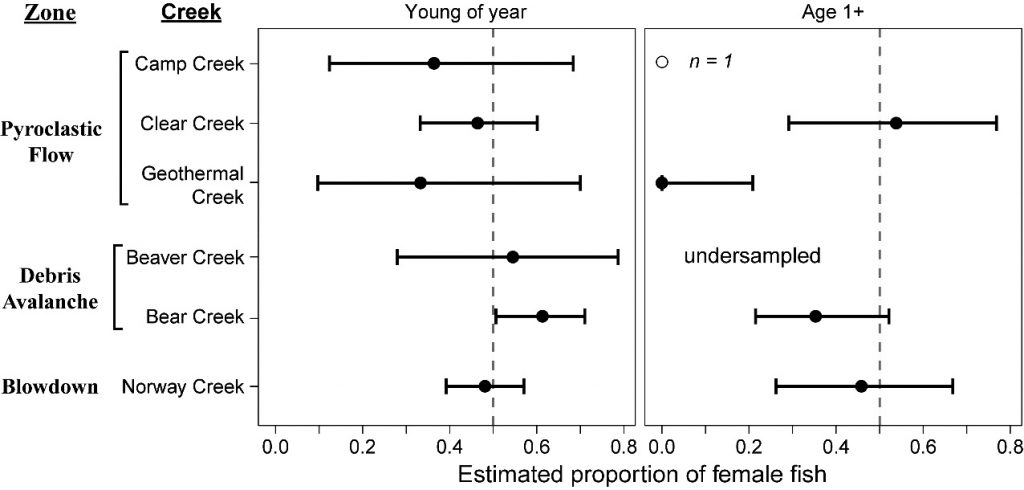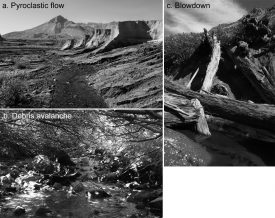by Tara Blackman, U.S. Forest Service, Pacific Northwest Research Station
Natural disturbances provide perspective on the recovery of freshwater ecosystems and the range of conditions under which salmonids can persist. The 1980 eruption of Mount St. Helens, Washington, USA, an intense broad-scale natural disturbance, provides a unique opportunity to observe the influence of disturbance on a recently established rainbow trout population in the Spirit Lake basin. Rainbow trout require stream habitat to spawn and rear, but express broad variation in life-history strategies that include migratory and non-migratory (resident) individuals even within the same population. Moreover, characteristics of migratory behavior, such as timing, can also vary by age and sex. Migration can have differential benefits for males and females (Jonsson 1985, Gross 1987). Female fecundity is limited by body size (Jonsson and Jonsson 1993) whereas male fitness depends on mating opportunities. Thus, females receive a greater benefit from migrating to places with more nutrient availability, where males can disproportionately benefit from residency and early maturation when that increases mating opportunities. As a result, sex ratios can be used as a proxy to assess different migratory behavior between sexes.
In this study, we are interested in the role of disturbance on these life history characteristics; particularly sex-specific responses to streams flowing though different types of disturbance. Spirit Lake basin rainbow trout are primarily adfluvial (migrating from stream-to-lake), but there is a dearth of information about the stream-dwelling portion of their life history. Tributaries to Spirit Lake drain a landscape formed by different volcanic disturbance types and mechanisms. The consequences for drainage networks ranged from complete destruction in the Pyroclastic Flow (PF) zone, to deposition of landslide material over the former stream channel in the Debris Avalanche (DA) zone, to the preservation of the former stream channel but denuding of all vegetation in the Blowdown Forest (BD) zone (Figure 1a-c). These varied zones provided a disturbance gradient to investigate how biophysical disturbance influences rainbow trout behavior in streams.
Methods of data collection
Demographic information including length, weight, age, sex, and reproductive status was collected from a sub-sample of fish from each stream throughout the Spirit Lake basin. Age was determined from sagital otoliths (the inner ear bone) by counting daily and annual growth rings, much like counting tree rings. Sexually mature individuals were identified by examination of gonads via dissection. The sex of non-mature and young-of-year fish was determined with polymerase chain-reaction (PCR) based sex genotyping. We evaluated sex ratios using a test for equality of proportions between males and females within respective age classes in each stream. A two-sample test for equality of proportions was used for between age-class comparisons.
Sex-specific responses across the disturbance gradient
We found two dominant age-classes that included young-of-the-year (0+ fish) and one-year-olds (1+ fish). Age 0+ fish appeared to have roughly equal sex ratios (male to female) while age 1 fish ranged from 100% male-biased in two PF streams, a slight male-bias in one DA stream, to a roughly 1:1 ratio in all other streams (Figure 2). Sex ratios indicate that females had variable responses to local environments, with fish in the more stable BD and DA streams having prolonged stream rearing and those in the more unstable PF zone showing a much more variable response. Moreover, the majority of all 1+ males captured regardless of stream of origin or growth pattern (size-at-age) were mature. The average size of mature males captured in streams was small, about 135mm, which is roughly 3.6 times smaller than mature males in Spirit Lake.

Figure 2. The proportion of female fish shown for young-of-year fish and age 1 with estimated 95% confidence intervals from a test of equality of proportions. The dashed line represents a 1:1 ratio of female to male fish.
Female vs. male strategies
Rainbow trout across the Spirit Lake basin disturbance gradient have expressed sex-specific life-history strategies creating a mating system comprised of exclusively adfluvial females and both adfluvial and early-maturing resident males (age 1+). While a female resident life-history was not observed per se, variable sex ratios between ages suggests that early (young-of-year) versus delayed (age 1-2) emigration to Spirit Lake by females was associated with local environment. Since growth is generally the limiting factor for female fitness, potential for individual streams to grow fish across the disturbance gradient appeared to influence female behavior. Sex ratios between young-of-year and age 1+ indicated that streams with the largest size-at-age (faster growing) females and smallest size-at-age (slower growing) females were associated with male biased populations. However, streams with intermediate levels of growth had even sex-ratios. Thus, growth patterns early in life have sex-specific consequences that are apparent at sub-population levels.
For males, an early-maturing (age 1+) phenotype was the dominant life-history strategy in streams across all disturbance zones, including areas undergoing secondary and primary succession. The streams in our study do not appear to support fish past age 2 (regardless of sex), likely due to spawning costs (for males) and/or space and resource limitations. These limitations are hypothesized to incentivize conditional maturation at age 1 to successfully spawn in late spring by age 2 before emigrating to Spirit Lake or perishing.
Given that only a single mature resident female was observed, early maturing males likely rely on a sneaking strategy to out-compete much larger adfluvial males. Sneaking tactics are highly successful in many salmonines (Fleming and Reynolds 2004) particularly because arrival time to breeding sites may limit spawning opportunity for adfluvial males, whereas resident sneakers potentially have access to mates throughout the spawning season, therefore increasing mating attempts. We surmise that early maturing males may have an added selective advantage in frequently disturbed systems where redds (nests) are susceptible to scour and therefore spawning with multiple partners may enhance individual fitness by increasing the likelihood that some redds will be successful.
We infer adfluvial life-histories in Spirit Lake are disproportionately large due to fitness benefits analogous to anadromy given the nutrient-rich productivity in the lake and low risk of migration (i.e., limited predation and short migration distance). Despite the assumed benefit to rearing in Spirit Lake, variability in sex ratios across the disturbance gradient suggests that environmental disturbance is likely a powerful force shaping migratory behavior and life-history characteristics in rainbow trout. Examining individual and population responses to streams in novel and early successional environments may improve our understanding of how some species succeed or fail to colonize disturbed habitat.
Literature cited
Fleming, I.A., and Reynolds, J.D. 2004. Salmonid breeding systems. In Evolution illuminated: salmon and their relatives. Oxford Univ. Press. New York. pp. 264–294.
Gross, M.R. 1987. Evolution of diadromy in fishes. In American fisheries society symposium. pp. 14–25.
Jonsson, B. 1985. Life history patterns of freshwater resident and sea-run migrant brown trout in Norway. Trans. Am. Fish. Soc. 114: 182–194. Taylor & Francis.
Jonsson, B., and Jonsson, N. 1993. Partial migration: niche shift versus sexual maturation in fishes. Rev. Fish Biol. Fish. 3: 348–365. Springer.










